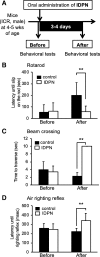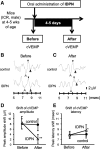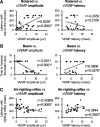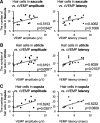cVEMP correlated with imbalance in a mouse model of vestibular disorder
- PMID: 31153359
- PMCID: PMC6545207
- DOI: 10.1186/s12199-019-0794-8
cVEMP correlated with imbalance in a mouse model of vestibular disorder
Abstract
Background: Cervical vestibular evoked myogenic potential (cVEMP) testing is a strong tool that enables objective determination of balance functions in humans. However, it remains unknown whether cVEMP correctly expresses vestibular disorder in mice.
Objective: In this study, correlations of cVEMP with scores for balance-related behavior tests including rotarod, beam, and air-righting reflex tests were determined in ICR mice with vestibular disorder induced by 3,3'-iminodipropiontrile (IDPN) as a mouse model of vestibular disorder.
Methods: Male ICR mice at 4 weeks of age were orally administered IDPN in saline (28 mmol/kg body weight) once. Rotarod, beam crossing, and air-righting reflex tests were performed before and 3-4 days after oral exposure one time to IDPN to determine balance functions. The saccule and utricles were labeled with fluorescein phalloidin. cVEMP measurements were performed for mice in the control and IDPN groups. Finally, the correlations between the scores of behavior tests and the amplitude or latency of cVEMP were determined with Spearman's rank correlation coefficient. Two-tailed Student's t test and Welch's t test were used to determine a significant difference between the two groups. A difference with p < 0.05 was considered to indicate statistical significance.
Results: After oral administration of IDPN at 28 mmol/kg, scores of the rotarod, beam, and air-righting reflex tests in the IDPN group were significantly lower than those in the control group. The numbers of hair cells in the saccule, utricle, and cupula were decreased in the IDPN group. cVEMP in the IDPN group was significantly decreased in amplitude and increased in latency compared to those in the control group. cVEMP amplitude had significant correlations with the numbers of hair cells as well as scores for all of the behavior tests in mice.
Conclusions: This study demonstrated impaired cVEMP and correlations of cVEMP with imbalance determined by behavior tests in a mouse model of vestibular disorder.
Keywords: Balance; Hair cells; IDPN; Vestibule; cVEMP.
Conflict of interest statement
The authors declare that they have no competing interests.
Figures





Similar articles
-
The vestibular evoked myogenic potential (VEMP): air- versus bone-conducted stimuli.Ear Hear. 2011 Nov-Dec;32(6):e6-e15. doi: 10.1097/AUD.0b013e3182280299. Ear Hear. 2011. PMID: 22033196 Clinical Trial.
-
The influence of unilateral saccular impairment on functional balance performance and self-report dizziness.J Am Acad Audiol. 2011 Sep;22(8):542-9; quiz 560-1. doi: 10.3766/jaaa.22.8.6. J Am Acad Audiol. 2011. PMID: 22031678
-
Vestibular Evoked Myogenic Potentials and Postural Control in Adults with Age-Related Hearing Loss.J Am Acad Audiol. 2021 Oct;32(9):567-575. doi: 10.1055/s-0041-1735521. Epub 2022 Feb 17. J Am Acad Audiol. 2021. PMID: 35176800
-
Potential application of ocular and cervical vestibular-evoked myogenic potentials in Meniere's disease: a review.Laryngoscope. 2013 Feb;123(2):484-91. doi: 10.1002/lary.23640. Epub 2012 Oct 15. Laryngoscope. 2013. PMID: 23070719 Review.
-
Vestibular evoked myogenic potentials: review.J Laryngol Otol. 2010 Oct;124(10):1043-50. doi: 10.1017/S0022215110001234. Epub 2010 Jun 2. J Laryngol Otol. 2010. PMID: 20519040 Review.
Cited by
-
Multidisciplinary approach to assess the toxicities of arsenic and barium in drinking water.Environ Health Prev Med. 2020 May 27;25(1):16. doi: 10.1186/s12199-020-00855-8. Environ Health Prev Med. 2020. PMID: 32460744 Free PMC article. Review.
-
New model of superior semicircular canal dehiscence with reversible diagnostic findings characteristic of patients with the disorder.Front Neurol. 2023 Jan 19;13:1035478. doi: 10.3389/fneur.2022.1035478. eCollection 2022. Front Neurol. 2023. PMID: 36742050 Free PMC article.
-
Balance beam crossing times are slower after noise exposure in rats.Front Integr Neurosci. 2023 Jul 11;17:1196477. doi: 10.3389/fnint.2023.1196477. eCollection 2023. Front Integr Neurosci. 2023. PMID: 37497526 Free PMC article.
-
Model of superior semicircular canal dehiscence: asymmetrical vestibular dysfunction induces reversible balance impairment.Front Neurol. 2024 Oct 28;15:1476004. doi: 10.3389/fneur.2024.1476004. eCollection 2024. Front Neurol. 2024. PMID: 39534266 Free PMC article.
-
Subtle alterations of vestibulomotor functioning in conductive hearing loss.Front Neurosci. 2023 Aug 29;17:1057551. doi: 10.3389/fnins.2023.1057551. eCollection 2023. Front Neurosci. 2023. PMID: 37706156 Free PMC article.
References
MeSH terms
Substances
Grants and funding
- 16H01639/Ministry of Education, Culture, Sports, Science and Technology
- 18H04975/Ministry of Education, Culture, Sports, Science and Technology
- 15H02588/Ministry of Education, Culture, Sports, Science and Technology
- 17KT0033/Ministry of Education, Culture, Sports, Science and Technology
- 16K08343/Ministry of Education, Culture, Sports, Science and Technology
- 16K10152/Ministry of Education, Culture, Sports, Science and Technology
- 17K09156/Ministry of Education, Culture, Sports, Science and Technology
- 15H01743/Ministry of Education, Culture, Sports, Science and Technology (JP)
- 25460178/Ministry of Education, Culture, Sports, Science and Technology (JP)
- 16K11177/Ministry of Education, Culture, Sports, Science and Technology (JP)
LinkOut - more resources
Full Text Sources
